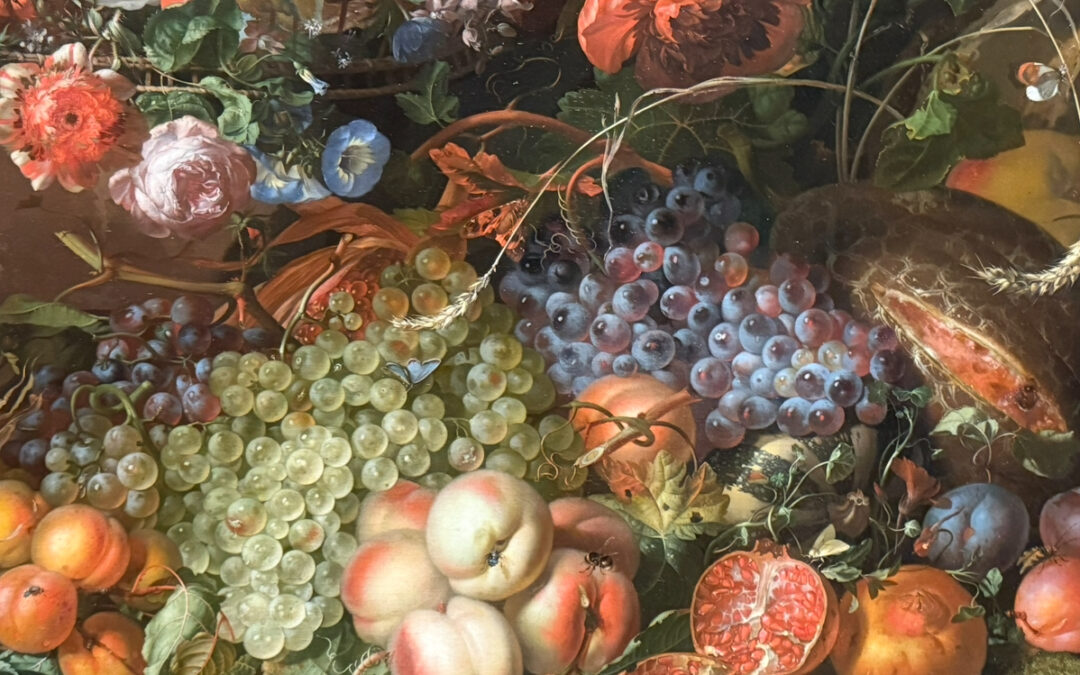Boston’s Museum of Fine Arts invites you to discover, wonder and study Rachel Ruysch’s work in the exhibit ” Artist, Naturalist and Pioneer”

Rachel Ruysch : (Dutch) Still Life with Fruit, 1711 ( Galleries Uffizi, Florence) Commissioned for Cosimo iii de’Medici, Grand Duke of Tuscany, Note the listing grapes and blue lizard, and praying mantis as foils
If you’re seeking Thanksgiving day centerpiece inspiration look back at this Dutch gal’s paintings. With a flare for the dramatic her signature-style has major game, it’s also dazzlingly allegorical!

Rachel Ruysch ( Dutch) Self portrait : oil on canvas, 1692 with collaborator, Michiel van Musscher, 1645-1705
Ruysch’s master-works feature voluptuous bouquets filled with blossoms at peak perfection. The arch of their exotic stems, the intensity of their saturated colors capture the fullness of their beauty. Complimenting the natural forms, fruits rest on draped table-scapes enhancing the natural setting of abundance. But, look closely at the composition, the artist hints at darker things. Insects and reptiles of all sorts contribute to the her thesis. ‘Where there is natural beauty, inevitably there will be decay and death.’

Now through December 7th “Artist, Naturalist, and Pioneer” celebrates the art as well as the philosophy of an extraordinary talent. Gathered from museums and private collections across the United States and Europe this exhibit of 35 ‘still-life’s’ possesses the power to move you.

Rachel Ruysch: (Dutch) “Still Life of Exotic Flowers on a Marble Ledge” 1735 Oil on canvas. Contrasts 36 flowers from around the world with symbols of decay
Ruysch drew inspiration from her famous father’s occupation. Benefiting from living on an 18th century trade-route, Dr. Fredrick Ruysch’s work as an anatomist and botanist included studies of specimens from around the globe. For him, the examination of insects revealed the marvels of creation.

Specimens :Presented by Professor of Organismic and Evolutionary Biology Charles Davis, Harvard University : Harvard Museum of Comparative Zoology

For the artist, the creatures were essential parts of a marvelously metaphorical narrative on the morbid currents of life. Accompanying Rachel Ruysch’s opulent petals are omens. As one of the few woman of her time allowed to join the ‘old-boys-painting-club’ she used symbolism to add dimensional thinking to her painted poetry. Centuries after her lifetime, we’re left to wonder if these still-life commentaries were more than moving observations of life-cycles but political riffs on the vanities of colonial power and unintended environmental disruptions.
If you find floral inspiration in the work of Rachel Ruysch, this year your Thanksgiving centerpiece may also be served as food for thought!
Discover more from She The People News explores the world of business, culture and politics from a woman’s point of view.
Subscribe to get the latest posts sent to your email.


